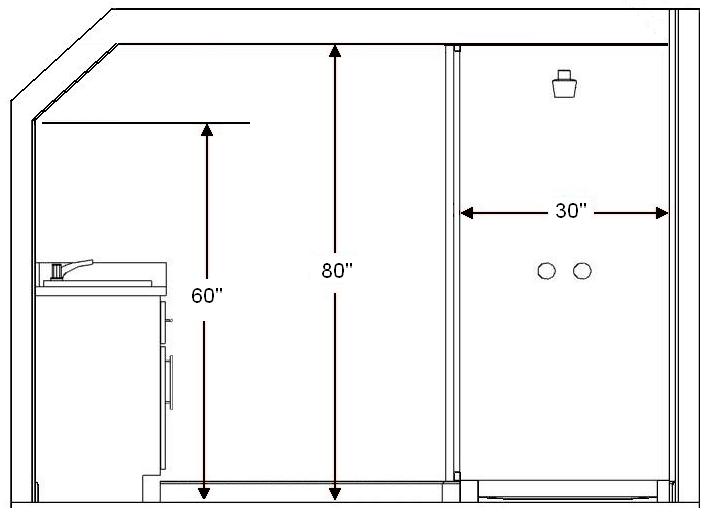Dear readers, we present to you the Standard Bathroom Rules and Guidelines with Measurements which will answer common questions when designing a standard size bathroom.
Bathroom planners should develop a strategy of using these recommended designs to solve the difficulties that people meet everyday when using a bathroom. Every detail in the bathroom counts in order to have the ideal design and maximum functionality.
This includes the best dimensions for installing the bathroom elements and most appropriate location of each element: standard bath height, standard toilet size, bathroom door dimensions, toilet clearance dimensions, standard tub height, and minimum shower size.

Bathroom Doorway Recommendation: 32″
To obtain a minimum clear opening of 32″ a door of minimum 34″ width is required. A minimum clear width of 34″ is the universal design. The absolute smallest allowable opening is 24″, but only if the existing walls prohibit any modifications.
How to measure a door’s clear opening? If you measure from doorjamb-to-doorjamb when the door is open, this measure the door’s opening but not the door’s clear opening. To calculating the clear opening, measure from the inside of the door to the other side of the opening while the door is open. Usually, this clear opening measurement will be around 2 inches less than the door opening. Ignore doorknobs when taking these measurements.

Toilet Stall Room Size Recommendation: 36″ by 66″
The recommended size for separate toilet stalls (also called a toilet compartments) with either a swing doors or pocket doors, is at least 36 inches by 66 inches. This is also the recommended size for a bidet compartment. Change this minimum recommended width to 60″ if the stall is to be made wheelchair accessible.
The absolute minimum, which is Building Code Requirement IPC 405.3.1, calls for a size of 30″ by 60″. However, the recommended size is ideal.
This recommendation is only for a toilet stall that has a door. However, in fact, more commercial toilet rooms are built without doors than with doors.
A bathroom stall door that swing inward can be used if the width of the door is added to the calcluation of the compartment’s length. If the inswing door is 24″ and you wish to have the recommended stall length of 66″, add the two for a new total length of 90″.
What if the compartment needs to contain both a toilet and a wall urinal? Or a toilet and a bidet? If this is the case, 18″ is the recommended distance betwee the center of the toilet and a wall or another bath fixture such as a urinal. Depending on the width of this other bath fixture, this extends the minimum recommended width by an additional 26″-29″ for a total width of between 62″ and 65″.

Shower/Bathtub Control Location Recommendation
A bathroom’s shower controls need to be accessible when the user is standing inside and outside the spray of the shower. Also, it should be located between 38″ to 48″ from the shower floor. The showerhead needs to be positioned between 66″ and 81″ above the floor. These measurements can be altered to accomidate the height of the homeowner.
Tub controls in a bath should also be reachable from both inside and outside the bathtub. It’s locations needs to be between the boundaries of the bathtub rims (ideally in the center) and positioned a maximum of 33″ above the floor.

Shower Seat, Shower Chair, & Shower Bench Placement Recommendation: 15″ deep shower seat installed 17″ to 19″ above floor of shower.
The absolute minimum, and building code requirement IRC P 2708.1, is that the shower seat not infringe on the 900 square inch minimum interior size of the shower.
Although a shower seat is not required, it is a good idea and requested by many homeowners. When remodelling a shower, a shower seat or bench should be considered.
Many local building codes require that the shower seat be located outside of a 30 inch diameter circle. The edge of this circle touches where the showerhead is located. This allows for ample room when standing and not sitting on the seat.
Shower seats and benches can be difficult to install in smaller sized showers. One solution to reduce a seats footprint when remodelling a small bath shower, is to go with a fold-up seat. When folded down, the seat should still be outside the 30 inch circle mentioned above.

Lavatory and Vanity Height Recommendation: Variable between 32″ and 43″ in height according to user preference.
In the past, the standard vanity height of 32″ was chosen as the best height mainly for children, but it is now outdated. After the children grow, adults are unfortunately left for decades with a vanity that is far to low.
The current, and better method, is to install a vanity at the factory standard of 36″. Children use a footstool to reach the sink. However, this is still either too low or too high for many people.
The best method is to install a vanity at the height requested by the user. This can be as low as 32″ or as high as 43″ depending on the height of the person.

Lavatory/Sink Placement Recommendation: There should be a least 20″ distance from the center of the sink to the wall, cabinet, or other fixture.
Building code IRC 405.3.1 requires a minimum distance of 15″ between a wall and the center of the countertop lavatories. This is 5″ less than the recommended distance.
Building code IRC R 307.2 calls for a minimum distance of 4″ between a wall and the edge of a freestanding or wallhung lavatory. This requirement is so there is adequate room to clean the sides of the sink. Freestanding and wallhung lavatories must also meet the 15″ requirement as well.
Pay close attention to the size of the sink when remodeling a small bathroom. Otherwise, the required minimum distance to the wall may not be met. Sink manufacturers offer sinks designed for smaller bathrooms.

Double Lavatory/Sink Placement Recommendation: Distance of at least 36″ between the center of the two sinks.
Building code IPC 405.3.1 requires a minimum distance of 30″ between the center of two lavatories, and building code IRC R 307.1 calls for a minimum distance of 4″ between edges of two freestanding or wallhung lavatories. Also, double lavatories must meet all requirements of single lavatories.
Adding an additional 6 inches to the minimum distance requirement, for a total of 36″, makes for better functionality.
When remodeling a smaller bathroom, it is important to be aware of how important the width of the lavatory sinks are in order to meet the mimimum offset distance.

Floor Space Clearance Recommendation: There should be at least 30″ of floor space between the front of each lavatory/washbasin, bathtub, shower, toilet, or bidet and an opposite object or wall.
Building code IRC R 307.1 requires at least 21″ clearance in front of every lavatory/washbasin, bathtub, toilet, or bidet. Notice that shower is not on this list. For showers, IRC P 2705.1.5 calls for 24″ of floor space in front of any entry to a shower.
These 21″ and 24″ minimum requirements is not enough space for most people. The recommended 30″ of floor space clearance should be used when remodeling a bathroom as it is better for the functionality. Of course, older bathrooms built many years ago can be as small as 5 feet across, and the recommended floor space may be impossible to achieve.
In addition, allow for 4″ between any wall and a clawfoot or freestanding bathtub. This way, the back and sides of the tub can be accessed for cleaning.
One way to meet the recommended clearance in a small bathroom is to use smaller toilets and sinks. With planning, small corner sinks can be installed or vanity depths can be reduced from 21″ to 15″.
Furthermore, an door that swings outward instead of inward should always be used in small bathrooms unless the adjacent room prohibits this in some way.

Bathroom Ceiling Height Recommendation: Bathroom floor to ceiling height of at least 80″. If the shower or bathtub has a showerhead, then the minimum floor to ceiling height of 80″ must be above an area of not less than 30″ by 30″ at the showerhead.
Building code requirement IRC R305.1 is the same as the recommendation.
This means the minimum shower size is 30″ x 30″ x 80″ which is too small for most people. A more appropriate minimum size is 32″ by 32″.
For bathrooms with sloped ceilings, the required floor area of the room should have a ceiling height of at least 60″ where people do not walk. This is important when remodeling bathrooms in basements, attics, or in areas with ducting or pipes that reduce the ceiling height. As long as it is safe, officials may allow an even lower sloped ceiling.

Bathroom Door Placement Recommendation: Entry and shower stall doors should not interfere with the use of sinks, toilets, fixtures, drawers, cabinets, or other doors.
There are no International Residential Code requirements for this category but these recommendations are appropriate.
When opened, doors should not hit another fixed object or anyone standing in front of a sink or sitting on the toilet.
To eliminate interference from doors compeltely, the entry door should swing outward and not inward. This is especially useful for adding much needed space when remodeling small bathrooms. Free floor space is freed up where the inward door would have swung open.





